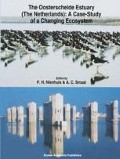Abstract
The benthic compartment forms a very important link within the estuarine ecosystem. It depends to a large extent on the import of food (plankton or detritus) from the pelagic system, and it serves as food for many predators, of which fish and birds are best known. However, both the primary production within the benthic compartment by macro- and microphytobenthos as well as the consumption by infauna predators may also be important energy pathways.
Access this chapter
Tax calculation will be finalised at checkout
Purchases are for personal use only
Preview
Unable to display preview. Download preview PDF.
References
Coosen, J., J. Seys, P. M. Meire&J. A. Craeymeersch, 1994a. Effect of sedimentological and hydrodynamical changes in the intertidal areas of the Oosterschelde estuary (SW Netherlands) on distribution, density and biomass of five common macrobenthic species: Spio martinensis (Mesnil), Hydrobia ulvae (Pennant), Arenicola marina (L.), Scoloplos armiger (Muller) and Bathyporeia sp. Hydrobiologia 282/ 283 (Dev. Hydrobiol. 97): 235–249.
Coosen, J., F. Twisk, M. W. M. van der Tol, R. H. D. Lambeck, M. R. van Stralen &P. M. Meire, 1994b. Variability in stock assessment of cockles (Cerastoderma edule L.) in the Oosterschelde (in 1980–1990), in relation to environmental factors. Hydrobiologia 282/283 (Dev. Hydrobiol. 97): 381–395.
De Jong, D. J., P. H. Nienhuis &B. J. Kater, 1994. Microphytobenthos in the Oosterschelde estuary (The Netherlands), 1981–1990; consequences of a changed tidal regime. Hydrobiologia 282/283 (Dev. Hydrobiol. 97): 183–195.
De Kluijver, M. J. &R. J. Leewis, 1994. Changes in the sublittoral hard substrate communities in the Oosterschelde estuary (SW Netherlands), caused by changes in the environmental parameters. Hydrobiologia 282/283 (Dev. Hydrobiol. 97): 265–280.
Hummel, H., A. W. Fortuin, R. H. Bogaards, A. Meijboom &L. De Wolf, 1994. The effects of prolonged emersion and submersion by tidal manipulation on marine macrobenthos. Hydrobiologia 282/283 (Dev. Hydrobiol. 97): 219–234.
Meire, P. M., H. Schekkerman &P. Meiniger, 1994b. Consumption of benthic invertebrates by waterbirds in the Oosterschelde estuary, SW Netherlands. Hydrobiologia 282/283 (Dev. Hydrobiol. 97): 525–546.
Meire, P. M., J. Seys, J. Buijs &J. Coosen, 1994a. Spatial and temporal patterns of intertidal macrobenthic populations in the Oosterschelde: are they influenced by the construction of the storm-surge barrier? Hydrobiologia 282/ 283 (Dev. Hydrobiol. 97): 157–182.
Meijer, A. J. M. &H. W. Waardenburg, 1994. Tidal reduction and its effects on intertidal hard-substrate communities in the Oosterschelde estuary. Hydrobiologia 282/283 (Dev. Hydrobiol. 97): 281–298.
Reise, K., 1985. Tidal Flat Ecology: an experimental approach to species interactions. Springer-Verlag, Berlin.
Seys, J. J., P. M. Meire, J. Coosen &J. A. Craeymeersch, 1994. Long-term changes (1979–89) in the intertidal macrozoobenthos of the Oosterschelde estuary: are patterns in total density, biomass and diversity induced by the construction of the storm-surge barrier? Hydrobiologia 282/ 283 (Dev. Hydrobiol. 97): 251–264.
Smaal, A. C. &R. C. Boeije, 1991. Veilig getij, de effecten van de waterbouwkundige werken op het getijdemilieu van de Oosterschelde. Nota WS 91.088, Rijkswaterstaat, Middelburg (in Dutch).
Smol, N., K. A. Willems, J. C. R. Govaere &A. J. J. Sandee, 1994. Composition, distribution and biomass of meiobenthos, in the Oosterschelde estuary (SW Netherlands). Hydrobiologia 282/283 (Dev. Hydrobiol. 97): 197–217.
Vos, P. C., 1989. Benthische diatomeeën celtellingen in de Oosterschelde en Voordelta. RWS nota GWAO 89.001 (internal report in Dutch).
Wiens, J., 1984. On understanding a non-equilibrium world: myth and reality in community patterns and processes. In: Strong, D. R., D. Simberloff, G. Abele &A. B. Thistle (eds), Ecological Communities. Conceptual Issues and the Evidence. Princeton University Press, Princeton: 439–457.
Author information
Authors and Affiliations
Editor information
Rights and permissions
Copyright information
© 1994 Springer Science+Business Media Dordrecht
About this chapter
Cite this chapter
Meire, P.M. (1994). The structure of the benthic system. In: Nienhuis, P.H., Smaal, A.C. (eds) The Oosterschelde Estuary (The Netherlands): a Case-Study of a Changing Ecosystem. Developments in Hydrobiology, vol 97. Springer, Dordrecht. https://doi.org/10.1007/978-94-011-1174-4_13
Download citation
DOI: https://doi.org/10.1007/978-94-011-1174-4_13
Publisher Name: Springer, Dordrecht
Print ISBN: 978-94-010-4512-4
Online ISBN: 978-94-011-1174-4
eBook Packages: Springer Book Archive

